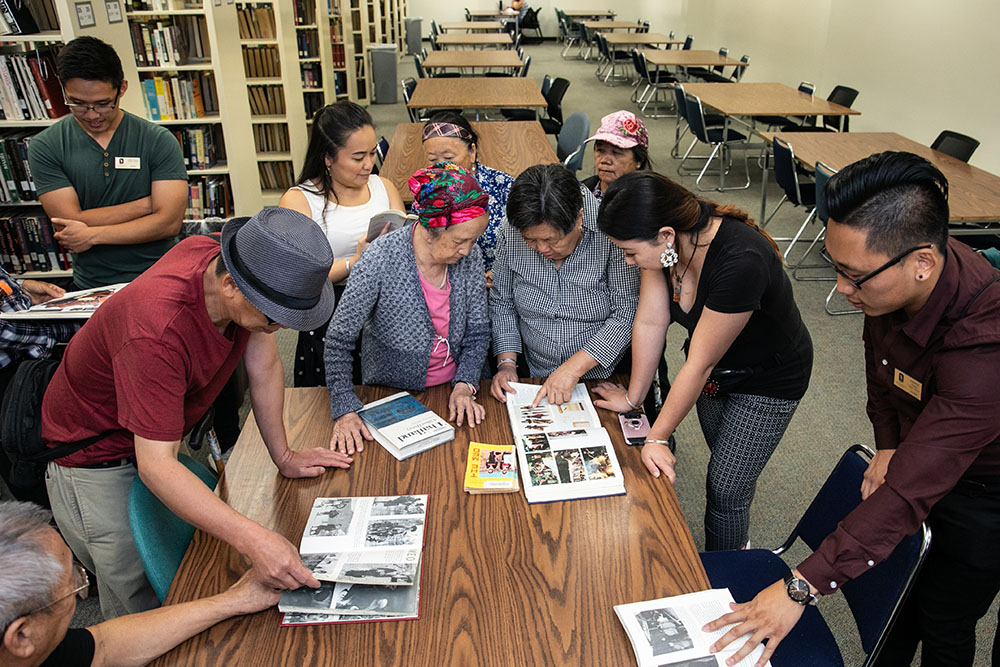 Hmong elders look through books at the University Library during their visit to Sacramento State. The visit was hosted by Sac State's Project HMONG. (Sacramento State/Andrea Price)
Hmong elders look through books at the University Library during their visit to Sacramento State. The visit was hosted by Sac State's Project HMONG. (Sacramento State/Andrea Price)
By Cynthia Hubert
Lu Lee had seen Sacramento State’s leafy campus before, but only from a distance when she dropped her granddaughter off for classes.
Like many of the Southeast Asian people who journeyed to America as refugees, she has no formal education, speaks little English, and had never thought about attending a university.
Now, thanks to an event hosted by Sac State’s Project HMONG earlier this month, Lee has a better understanding of why more Hmong youth are interested in going to college.
“I think it’s wonderful,” she said through a translator as she and a small group of other Hmong elders toured the campus for the first time. “But I feel a little sad, because there are so many opportunities here and I’m too old to take advantage of them.”
She plans to spread the word about Sac State’s offerings, she said, and encourage Hmong youth to pursue higher education.
“It’s the best thing that they can do,” she said.
Lee’s reaction was exactly what organizers had hoped for when they invited elders from the Sacramento area to campus in hopes of attracting more Hmong students to Sac State.
“The elders can see that we respect the culture and the responsibilities that go along with it, but that there is an opportunity outside of the culture as well,” said Chao Vang of Sac State’s Student Academic Success and Educational Equity Programs. Project HMONG is part of SASEEP.
Approval from Hmong elders, who are held in high esteem by young people in the culture, is key to motivating more Hmong youth to attend college, Vang said. Many youth never pursue college because they feel pressure to be rooted in their culture, attend family events, act as translators for older members of the family and stay close to home, he said. Project HMONG helps them navigate the social, financial, and academic challenges they face.
Sac State’s Hmong student population is steadily growing, said Vang. The University has more than 1,100 Hmong students, among the largest group in the country. About 31,000 Hmong live in the Sacramento area.
Ten Hmong elders attended the recent campus event. All of them take part in a day program sponsored by the nonprofit Hmong Youth and Parents United in North Sacramento.
The men and women, some walking gingerly and using canes, began their day with a breakfast of donuts, bagels, juice, and coffee in the University Union. They performed a few stretching exercises before heading out to explore other parts of the campus.
“There can be a huge disconnect between Hmong youth and elders” about attending college, said Pachia Vang, who works with the North Sacramento nonprofit organization. “This is a way of helping them to understand the importance of college, and to help humanize the college experience for them.”
After breakfast, the elders visited Sac State’s Library and marveled at its multitude of book collections. They spent time perusing titles including Of the Hills and Hmong Voices, which featured photographs that reminded them of their way of life in Laos before war drove them first to refugee camps in Thailand and then to the United States.
“These elders don’t have access to books like these, and the books remind them of their past experiences,” said Andrew Yang, a Sac State student and participant in SASEEP.
The tour also took them to the Library’s Sokiku Nakatani Tea Room, where members of the Sac State community and the public at large can take part in Japanese tea gatherings. They walked around the surrounding garden area and took pictures before visiting the Library’s Donald and Beverly Gerth Special Collections and University Archives, and having lunch.
Lee said her time on campus reinforced her belief that Sac State is a “community space” where everyone is welcomed.
“I think it was very important to do this, because so many of our young people are coming to school here now,” she said. “It’s good for us to understand what it is like.”
